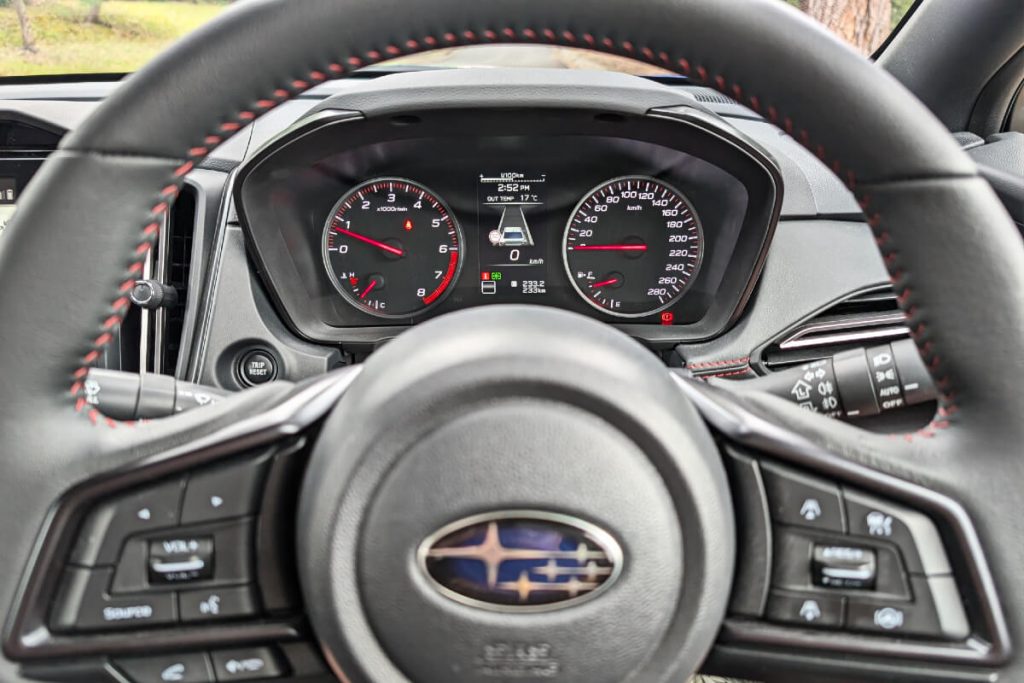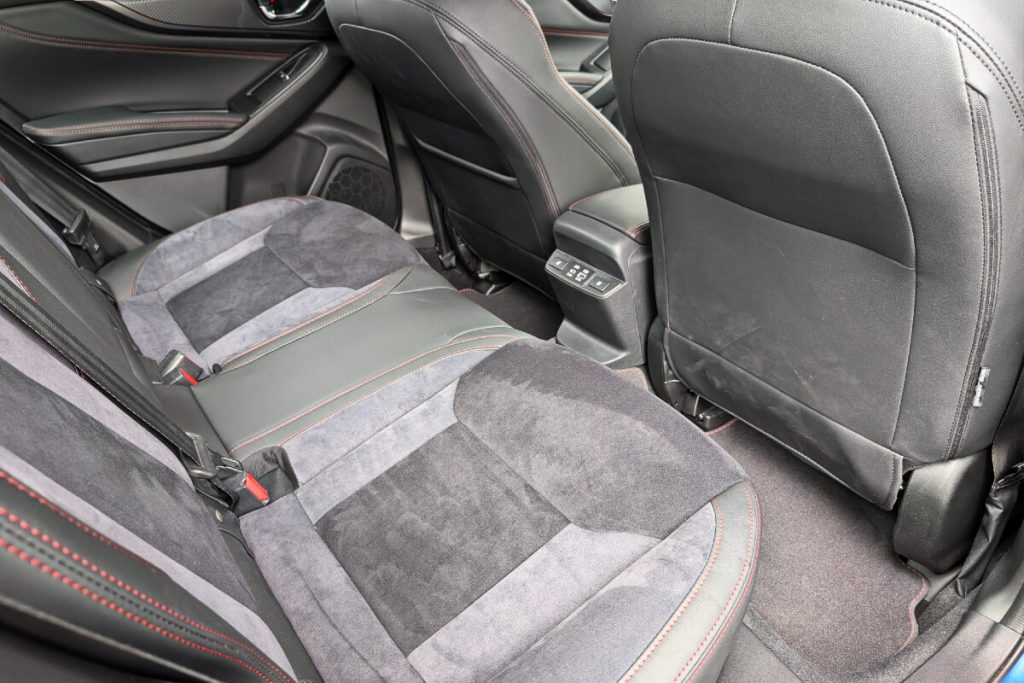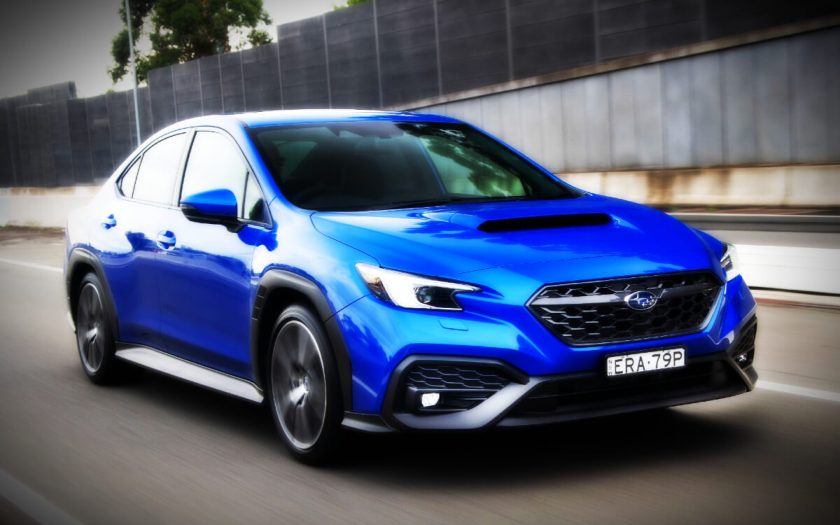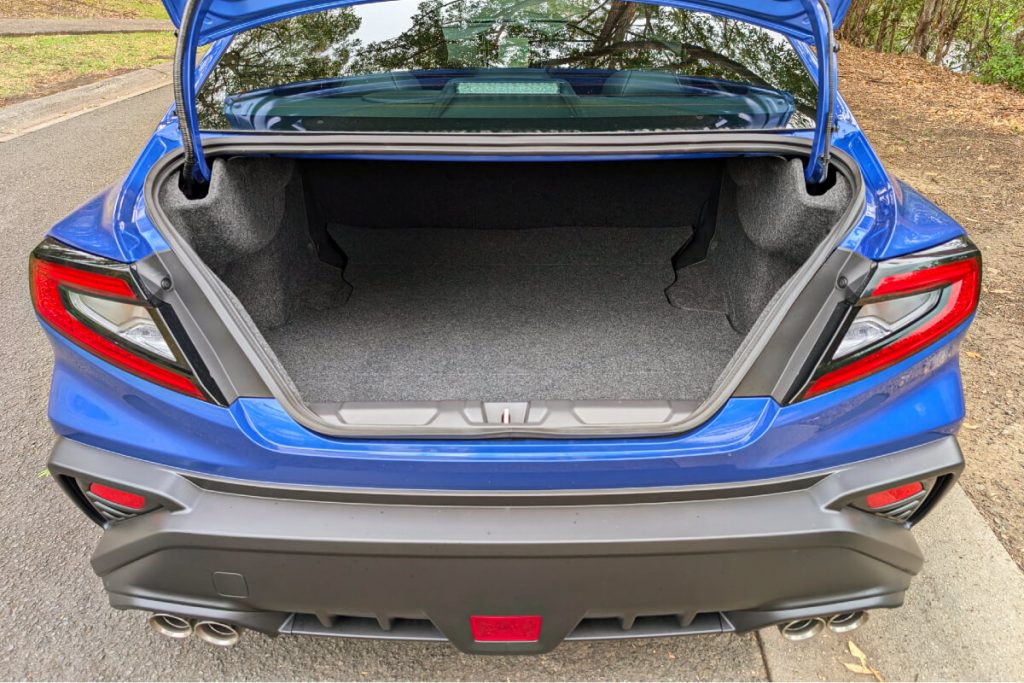Chris Riley tests the 2024 Subaru WRX RS AWD performance sedan with pricing, specs, ride and handling, safety, verdict and everything the over-50 driver needs to know.
Summary: Like something from the past, the Subaru WRX is a fast, yet practical small car. But if you want one, don’t waste time – we think it isn’t long for this world.
2024 Subaru WRX RS all-wheel drive performance sedan
Pricing: $54,490 (plus on road costs)
Warranty: Five-years, unlimited km, one year roadside assist
Safety: ANCAP rating expired
Engine: 2.4-litre turbo intercooled DOHC with VVT
Service intervals: 12 months or 15,000km
Power: 202kW @ 5600rpm
Torque: 350Nm @ 5200rpm
Transmission: six speed manual, four-wheel drive
Body: 4670mm (long); 1825mm (wide); 1465mm (high)
Build country: Japan
Kerb weight: 1585kg
Towing capacity: 1200kg
Luggage storage: 411L
Wheels: 18-inch alloy
Tyres: 245/40R18
Spare wheel: space saver
Ground clearance: 135mm
Turning circle: 11.2m
Fuel tank: 63 litres
Consumption: 9.9L/100km (95 RON unleaded)
Consumption on test: 13.2L/100km (400+km)
seniordriveraus consumption on test: not tested

[review]
I remember the first time I took my father-in-law for a blast in a WRX. It was the Club Spec Evo IV and it was the year 2000, or thereabouts.
“Are you ready?” I asked, preparing to floor it on a long straight.
He nodded.
Wooshda!
“Geez!” he managed, holding tightly to the armrest as he was forced back in his seat.
Tony’s dead now but nothing much has changed since those days 25 years ago.
The WRX, it’s just the WRX these days, is still one of the most exciting cars money can buy.
Competitors such as the EVO have come and gone, but the Rex soldiers on.
Its days must be numbered however as society moves away from the internal combustion engine.

What’s it cost?
The fifth and latest generation WRX was released in 2022.
Subaru has struggled to keep the price below $40K since launch in 1994, but somewhere along the line that battle was lost.
These days prices start from $44,990 for the manual or $48,990 for the auto – still very competitive.
I guess some people buy the auto, but those who fancy themselves as real drivers will be drawn to the manual, now with six gears and lockout reverse.
For $54,490 you can have the RS Manual, the subject of our review, while the top-of-the-line tS Sport Lineartronic is $56,990 – that’s an auto.
Prices for the Sportwagon, known briefly as the Levorg, start from $49,990. All wagons are auto only.
Standard equipment is extensive across the grades.
There’s cloth upholstery and two-zone climate air, 18-inch alloys, keyless entry and start, leather-wrapped tilt and reach adjust wheel, split-fold rear seats, auto lights and wipers (the LED headlights follow the wheels), electric parking brake, power-folding exterior mirrors and tyre pressure monitoring.
Our RS test vehicle ups the ante with Ultrasuede trim, power-adjust driver and front passenger seats, electric driver lumbar support, heated seats for front and outer rear seats, electric sunroof, ambient lighting, LED puddle lights, driver monitoring system, plus additional Vision Assist features including front and side view monitors.
Infotainment consists of an 11.6-inch portrait-style touchscreen, AM/FM and DAB+ Digital radio, wireless Apple CarPlay and Android Auto, Bluetooth with voice control and audio streaming, along with six-speaker audio.
The latter consists of 4 x 160mm full-range speakers, in the front and rear doors, plus two dash-mounted tweeters that we’re told not only deliver better sound than before, but bring a 15 percent weight reduction.
RS and tS sedans feature a premium Harman Kardon 10-speaker audio system with a 265mm subwoofer mounted on the rear parcel shelf. It incorporates ‘Clari-Fi’ and ‘GreenEdge’ digital technologies designed to restore audio quality lost during compression.
The entry grade misses out on satellite navigation, but it’s standard across the rest of the range.
All score AUX, USB-A and USB-C ports in the front, while RS and tS sedans and all Sportswagons, get a second set in the rear.
Physical buttons are provided for such things as the aircon, volume and tuning as well as the demister.
And, believe it or not, our RS has a single CD player hidden in the centre console.
But you won’t find wireless phone charging in any version of the WRX.
The safety rating for WRX expired in 2022 and it needs to be re-tested. Oops.
That said, it does come with eight airbags, a reversing camera and Subaru Vision Assist which has finally been added to manual versions.
This includes Autonomous Emergency Braking (AEB), adaptive cruise control, lane-departure warning and lead vehicle start alert.
There’s also Emergency Lane Keep Assist, Lane Centring Function, Lane Departure Prevention, Lane Sway Warning, Pre-Collision Braking System, Pre-Collision Brake Assist, Autonomous Emergency Steering, Brake Light Recognition and Speed Sign Recognition.
Also fitted are Blind Spot Monitor (BSM), EyeSight Assist Monitor (RS), Front View Monitor (FVM) (RS), High Beam Assist (HBA), Lane Change Assist (LCA), and Rear Cross Traffic Alert (RCTA).
However, the manual still misses out on Reverse Automatic Braking.
There are dual outboard ISOFix points, and three top-tether points for child seats.
The WRX is covered by a five-year warranty, with five-year/75,000km capped price servicing and 12 months roadside assistance.

What’s it go like?
It’s been said before but it bears saying again that the WRX still represents the best bang for your driver buck that money can buy.
It’s difficult to imagine anyone being disappointed with the performance of this car.
If you like driving, especially along leafy winding roads, and you enjoy the sensation of braking, down-changing and getting the timing just right as the car fires out of the corner again – then you’ll want the manual.
Just be aware however that it is a commitment in traffic and sitting on hills, balancing the clutch and throttle, waiting for the lights to go green, one that becomes tiring very quickly.
And although the WRX is pretty quick off the line, it takes some practice to achieve this feat in the manual.
Our best advice is to give it a squirt and get out of first as soon as you can. After that, it’s all go, go, go – but be sure to keep an eye on the tacho!
Under the bonnet is a larger, 2.4-litre turbocharged, horizontally-opposed four-cylinder engine (up from 2.0-litres).
Surprisingly, though, it produces just 5kW more than its predecessor, with 202kW of power at 5600 rpm and 350Nm of torque from 2000 to 5200 rpm.
The torque output is the same as before, but it’s produced lower in the rev range, generating high torque from lower engine speeds.
Drive is to all four wheels via a six-speed manual transmission (our test vehicle), or a CVT style auto with eight steps or gears.
But don’t be confused by all this talk of “symmetrical” all-wheel drive, because it doesn’t mean full-time four-wheel drive.
Most of the time the operates in front-wheel drive – the back wheels only come into play when needed.

Suspension is fully independent with MacPherson struts at the front and double rear wishbones.
The ride is pretty firm, even harsh depending on the surface, but it works a treat, particularly threading corners at a rate of knots.
Overtaking is a breeze.
The RS rides on black 18-inch wheels with 245/40 profile rubber, producing impressive grip.
The brakes are excellent.
Fuel consumption for the manual is rated at 9.9L/100km on the combined cycle and it takes premium 95 unleaded.
We were getting 13.2L/100km after more than 400km of mixed driving including 60 minutes of getting up it.
One of the big changes with the latest Rex has been the move to Subaru’s new global platform and the improvements that brings.
Stronger with less flex, it offers sharper handling and more comfort by reducing unpleasant road vibrations and shaking.
It features full inner-frame construction for high body and chassis rigidity and gives all-new WRX some 14 percent more front lateral flexing rigidity and 28 percent more torsional stiffness.
The sedan also incorporates a number of performance-inspired exterior design influences, including air outlets located on the trailing edges of the front wheel openings, side garnishes and a lip-style boot spoiler.
The air outlets at the rear of each front wheel enhance the car’s aerodynamic performance by drawing air from inside the guards.
Inside, the cabin features stylish black and grey upholstery on the sedan and black upholstery on the Sportswagon, with red stitching and a leather-wrapped steering wheel.
The instrument gauges are old school, not digital – but that’s all you need.

What we like
- Eyesight
- Great brakes
- Subaru has kept it simple
- You feel connected with the car
- Lots of mid-corner grip
What we don’t like
- Harsh ride
- Handbrake needs adjusting
- No rear air vents in the sedan
- Not big fans of the boot lip spoiler
- Rear legroom a little tight
What over-50s need to know
The WRX, once the Impreza WRX, is as practical as it is quick.
As such it’s not a big compromise to get behind the wheel of this car.
It’s easy to get in and out of, although the high-sided sports seats are not overly user-friendly.
The Rex is also just as happy to wander around as it is to go banging from corner to corner.
Like so many petrol-powered performance cars, the chances of getting your hands on a WRX are rapidly diminishing with the increasing take up of electric vehicles.
They’ve already dropped the STI to concentrate on the next generation EV performance variant.
The Rex is sure to follow sooner than later, so if you’re sitting on the fence, waiting for the right moment, the time might be nigh. There’s nothing worse than missing out.

seniordriver comments
Unlike the Solterra we reviewed recently, the WRX is a real Subaru, and one on which it has built its reputation over many years. Put simply, there are few cars that give you so much excitement for so little money (if you can call more than $50,000 “little money”).
It has always been a car for keen drivers (and that probably explains why the quoted fuel consumption of 9.9L/100km is so far short of the 13.2L/100km that Chris achieved in the car – but he did point out that some of that was down to “spirited” driving).
Cars like this will sooner rather than later be relegated to history, so if you want one, get in now.
The expiry of the ANCAP rating (and failure to have it retested) is of concern, even though there appears to be a full suite of safety functions, including Subaru Vision Assist which has finally been included on the manual versions.
As a practical performance car, the WRX has few peers. If you want even greater practicality, go for the Sportswagon.

